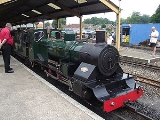
Aylsham railway station
Encyclopedia
This article is about the former Great Eastern Railway
station. For the Midland and Great Northern Joint Railway
station, see Aylsham North railway station
.
 Aylsham South railway station served the town of Aylsham
Aylsham South railway station served the town of Aylsham
in Norfolk
from 1880 to 1981. The period station buildings were subsequently demolished in 1990 to allow for the construction of the terminus of the Bure Valley Railway
, a narrow gauge
operation which reuses some of the trackbed of the old railway line.
There is a OO Gauge model railway in the station building.
, then run by the Great Eastern Railway
, it became part of the London and North Eastern Railway
during the Grouping
of 1923. The station then passed on to the Eastern Region of British Railways
on nationalisation in 1948.
In 1952 the passenger service stopped, but the freight service continued until 1977. In 1990, the station buildings - then one of the most complete remaining Great Eastern stations in Norfolk, were obliterated to make way for the Bure Valley Railway whose headquarters now occupy the site.
Great Eastern Railway
The Great Eastern Railway was a pre-grouping British railway company, whose main line linked London Liverpool Street to Norwich and which had other lines through East Anglia...
station. For the Midland and Great Northern Joint Railway
Midland and Great Northern Joint Railway
The Midland and Great Northern Joint Railway, was a joint railway owned by the Midland Railway and the Great Northern Railway in eastern England, affectionately known as the 'Muddle and Get Nowhere' to generations of passengers, enthusiasts, and other users.The main line ran from Peterborough to...
station, see Aylsham North railway station
Aylsham North railway station
This article is about the former Midland and Great Northern Joint Railway station. For the Bure Valley Railway station see Aylsham South railway station....
.

Aylsham
Aylsham is a historic market town and civil parish on the River Bure in north Norfolk, England, about north of Norwich. The river rises near Melton Constable, upstream from Aylsham and continues to Great Yarmouth and the North Sea, although it was only made navigable after 1779, allowing grain,...
in Norfolk
Norfolk
Norfolk is a low-lying county in the East of England. It has borders with Lincolnshire to the west, Cambridgeshire to the west and southwest and Suffolk to the south. Its northern and eastern boundaries are the North Sea coast and to the north-west the county is bordered by The Wash. The county...
from 1880 to 1981. The period station buildings were subsequently demolished in 1990 to allow for the construction of the terminus of the Bure Valley Railway
Bure Valley Railway
The Bure Valley Railway is a minimum gauge heritage railway in Norfolk, within The Broads National Park.The railway runs from Wroxham to Aylsham and is Norfolk's longest railway of less than standard gauge. It uses both steam and diesel locomotives. There are intermediate halts at Brampton,...
, a narrow gauge
Narrow gauge
A narrow gauge railway is a railway that has a track gauge narrower than the of standard gauge railways. Most existing narrow gauge railways have gauges of between and .- Overview :...
operation which reuses some of the trackbed of the old railway line.
There is a OO Gauge model railway in the station building.
History
Opened by the East Norfolk RailwayEast Norfolk Railway
The East Norfolk Railway was a standard gauge 25 mile, mostly single track, railway running between Norwich Thorpe railway station and Cromer in the English county of Norfolk. It opened in 1874, reaching Cromer three years later, and remains mostly operational...
, then run by the Great Eastern Railway
Great Eastern Railway
The Great Eastern Railway was a pre-grouping British railway company, whose main line linked London Liverpool Street to Norwich and which had other lines through East Anglia...
, it became part of the London and North Eastern Railway
London and North Eastern Railway
The London and North Eastern Railway was the second-largest of the "Big Four" railway companies created by the Railways Act 1921 in Britain...
during the Grouping
Railways Act 1921
The Railways Act 1921, also known as the Grouping Act, was an enactment by the British government of David Lloyd George intended to stem the losses being made by many of the country's 120 railway companies, move the railways away from internal competition, and to retain some of the benefits which...
of 1923. The station then passed on to the Eastern Region of British Railways
Eastern Region of British Railways
The Eastern Region was a region of British Railways from 1948. The region ceased to be an operating unit in its own right in the 1980s and was wound up at the end of 1992...
on nationalisation in 1948.
In 1952 the passenger service stopped, but the freight service continued until 1977. In 1990, the station buildings - then one of the most complete remaining Great Eastern stations in Norfolk, were obliterated to make way for the Bure Valley Railway whose headquarters now occupy the site.

